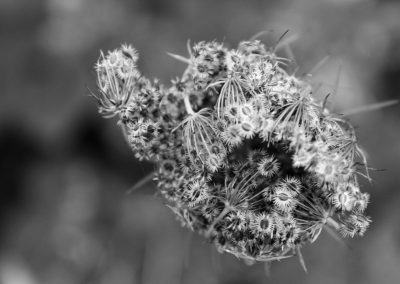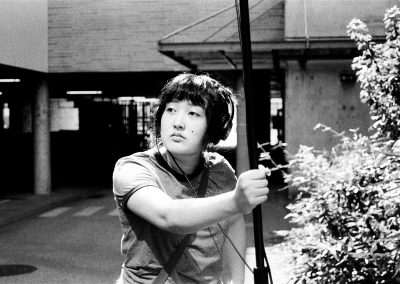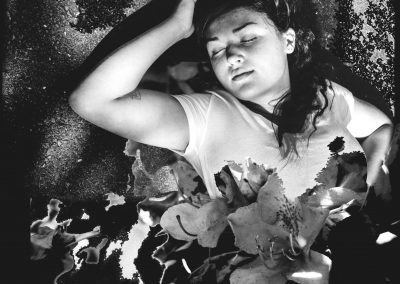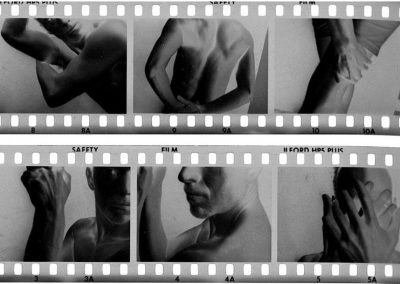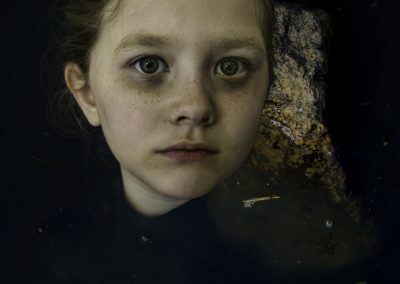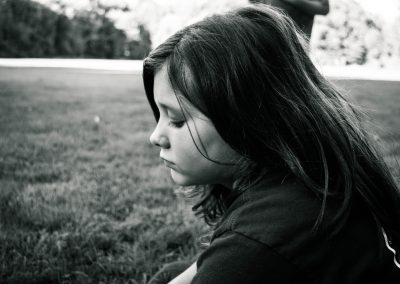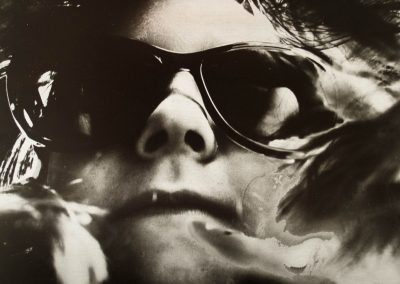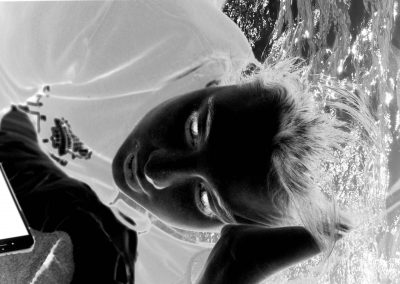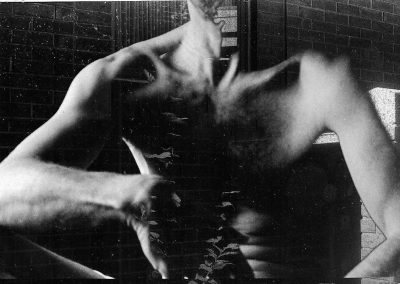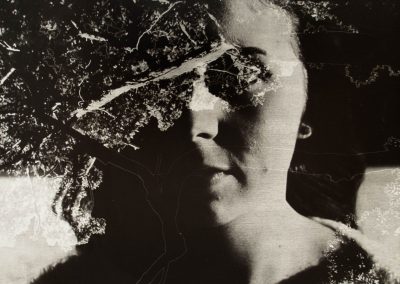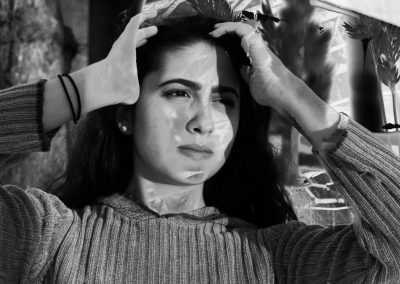Featured Artist
Molly Flanagan is a junior at Southern Connecticut State University. She studies Film/TV Production, Creative Writing, and Theatre. Molly focuses on writing for the stage and screen, but her original passion lies in photography and visual art. She uses a wide range of approaches in her photography: digital manipulation, overlapping digital negatives, and film printing. She loves the relationship between nature and man, and hopes the symbiosis will improve.

INTERVIEW
ANGLES: Hi Molly! Can you tell us a little more about yourself?
MF: Oh, god, I’m so boring. I am a junior at SCSU in New Haven, CT. I went to France this summer as part of a French film studies/filmmaking program. I lied to so many people over there. Every time someone asked where I went to school, I just said, “You know Yale? I’m like five minutes away.” But sometimes, for brevity, I’d just say I went to Yale. It’s quicker, y’know? Anyways, I’m not a pathological liar. I’m just lazy. And my laziness doesn’t really come across in my art because I always put my pieces through so many different layers of editing and manipulation. I’m interested specifically in mixed media production: photography, videography, and theatre. My personality and brain power are being taken over by my senior thesis: a double creative project where I’ll be adapting a single story into a play and a short film. As you can see from my work in Lifetimes, I love nature and I’m lucky enough to live in a coastal town with some nice wooded areas closer to my house. Growing up near nature, with a passion for animals and plantlife, I expected to be a witch when I grew up. Unfortunately, I’m just an artist.
ANGLES: We love the idea of this collection—the theme of lifetimes. How did the project evolve?
MF: “Lifetimes” definitely evolved over the few months I created the collection. The project started as a portrait series where I had my models stand in locations that felt foreign to them (whether it be in a cityscape or in a snowy woods). In these images, the subjects looked too small within the landscape, almost encapsulated by their surroundings. Mostly, the images looked so forced. After a few failed shoots of my models standing awkwardly in open landscapes, I reapproached the collection with less reign. I took pictures of natural elements (plants, trees, ocean, etc.) and manipulated them against candid images of my subjects. The final pieces are amalgamations of two parts: nature in nature and humans in their own element.
ANGLES: Do you have a favorite piece you’ve done (including or excluding the pieces here)?
MF: Ugh! Every time I get asked my “favorite” anything, I immediately forget everything I’ve ever liked in my life. I wouldn’t say I necessarily have a favorite piece, but I do have a favorite collection of images. I say “favorite” because I always come back to this collection. My dad and I were visiting my sister who lived in Harlem at the time, and I decided to bring a camera I borrowed from school as a way to practice with a DSLR. Before then, I had only used 35mm film cameras and simple digital cameras. This was the first time that I felt I had a grasp on how to manually use a “real” camera. On our way home from visiting my sister, I took pictures from the passenger seat of my dad’s car. My shutter speed was adjusted pretty high to get the fast moving shots, and the result was a collection of images of buildings in NYC. I love the graininess and the vividness of the color of film, so I edited the images to reflect this feel. I can’t explain why, but I still love all those images; it might come down to my relationship between the subject. I only had a second or two to get any of those images. Hanging out the passenger side window, there was a freedom in only having one chance to take an image. It forced me to take my photography seriously and limit my technical and compositional errors.
ANGLES: What does your process look like?
MF: I’m not sure if I have a process. I feel like I use photography as a means to edit. I love editing. There’s nothing more satisfying than putting on some music and sitting in front of a computer for hours staring at the same picture. Zero sarcasm. And I think “Lifetimes” developed from my love of editing. The process of creation went beyond just the taking of the images—it really matured in the manipulation process. The focus of these images became clear as I edited them. The images in the collection were not planned; each portrait and image of nature were candid and they only came together in this post-production process. To answer the question, my “process” is inductive: I start with the art itself, shape it into something, and then figure out my intentions.
ANGLES: What challenges did you face in developing this collection?
MF: The biggest challenge I faced in developing this collection came during the creation of the pieces manipulated in the darkroom. Specifically for the canvas print “J.”, I had to work through several methods in order to print that photo onto the material. Originally, I was going to use a type of light-sensitive paint and then print the photograph directly onto the canvas. The print never came out quite right (possibly because I was using a shared darkroom space and left the print vulnerable for light exposure). For the final piece, I printed the image onto a sheet and ironed it onto the canvas. Over a long period of time, the print won’t hold up and will start to pick off. I actually had to paint over a few places where the print didn’t stick to the canvas.
ANGLES: Most of the pieces are in black and white. What drew you to this style of photography for this body of work?
MF: I decided to go for a black and white theme for this collection because I wanted cohesiveness between the digital manipulations and the darkroom manipulations. All of the film images were shot in 35mm black and white. The kind of rippled flow that comes from the manipulation of the images is easier when color is stripped from the image. “Drowning” is not in black and white because the connection between the human subject and the natural element come down to the similar balance in colors; the grooves under her eyes resemble the crooks in the rock. I’ve always enjoyed working in the darkroom and I wanted that process to be a central element of the collection. Even some of the digital manipulations (DSLR captured images edited in Photoshop) were printed onto clear sheets (digital negatives) then printed again in the darkroom.
ANGLES: What inspires your creativity?
MF: Deadlines. I’m probably the worst artist because even though I have technical abilities that I’m always trying to hone, I don’t create art all the time. I have no real driving force or special interest in art that I’m constantly pursuing or researching. A few of the pieces in “Lifetimes” were created my senior year of high school as a kind of final concentration or thesis. As I approach my senior year of college, I’m beginning the early stages of my honors thesis: a study on audience reception to film and theatre. My interests have changed quite a bit, but the concept of deadlines and prompts make it easier for me to work towards a goal when I create art. But what inspires my actual creativity once I decide to create art? I would say other works of art. I watched a TED talk once about how all art is just a creative copy of other pieces of art (“Creativity is a remix,” Kirby Ferguson). The “remix” concept actually helps me get over the mental block when trying to think of what to create. I usually go back to my favorite films to get inspiration, or, like in Lifetimes, I go out into nature and just shoot.
ANGLES: How do choose the subjects of your work?
MF: For the exception of two subjects, all of the models in Lifetimes are my friends. The model in “Party Chair” and “Untitled. Scans of a Model” was hired for one of my early 35mm photography courses. In “Party Chair,” I recycled an image of him and overlaid it with another 35mm scan. To me, the movements of his body resembled the branches of trees, so instead of manipulating those images for two pieces, I decided to include the original scans to show the early, pre-production stage. All of the other subjects were shot outside of a studio setting while I was hanging out with friends: some shot in bed, outside, in the woods, etc. The subject in “Ex” is me—who, surprisingly, you don’t see nearly as much of in this collection. In my drawing pieces, I use myself as a model almost exclusively because of conveniency and ability to manipulate my face with different media (markers, pens, colored pencils, oil paint, etc.) and to distort it in various ways.
ANGLES: How do you plan on working with art post-graduation?
MF: Even though earlier I said that I have moved away from fine art and photography in college, I’ve considered the idea of pursuing it again after I graduate. For me, my skills in filmmaking always come back to what I’ve learned in photography. Many cinematographers studied photography in school and then went on to become directors of photography later in their careers. I want to study photography, writing, drama, and filmmaking and I want to spend my time carefully with each one. Post-graduation, I plan on taking more fine arts classes specifically in photography, videography, and mixed-media production. The structure of class and school helps me create because of the community, deadlines, and prompts. To answer the question more directly, I plan to never stop working with art post-graduation. I’ve worked my whole life with different media and I love to play around with every resource imaginable.
